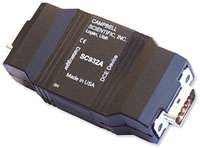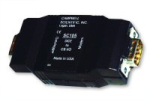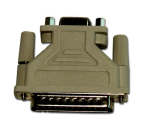
Overview
The SC932A supports two-way communications between a datalogger and a device that is configured with an RS-232 DCE serial port. Common Campbell Scientific devices used with the SC932A include our SRM-5A RAD Short Haul Modem and RavenXT-series digital cellular modems. The SC932A can also be used with third-party fiber optic modems, Hayes-compatible modems, satellite transmitters, and spread-spectrum radios. The SC932A is compatible with any datalogger that has a CS I/O port.
Read MoreBenefits and Features
- Communicates at baud rates up to 115.2 kbps
- Provides true RS-232 signal levels
- Compatible with most Campbell Scientific data loggers
Images

Technical Description
The SC932A is a 9-pin to 9-pin interface. Modems with a 25-pin DCE serial port, such as the SRM-5A, connect to the SC932A via the 15751 adapter.
This interface provides true RS-232 signal levels. It does not support one-way output or printers; our SC105 interface is recommended for those applications.
Compatibility
Please note: The following shows notable compatibility information. It is not a comprehensive list of all compatible products.
Dataloggers
| Product | Compatible | Note |
|---|---|---|
| 21X (retired) | ||
| CR10 (retired) | ||
| CR1000 (retired) | ||
| CR10X (retired) | ||
| CR200X (retired) | ||
| CR211X (retired) | ||
| CR216X (retired) | ||
| CR23X (retired) | ||
| CR3000 (retired) | ||
| CR500 (retired) | ||
| CR5000 (retired) | ||
| CR510 (retired) | ||
| CR6 | ||
| CR800 (retired) | ||
| CR800 (retired) | ||
| CR800 (retired) | ||
| CR850 (retired) | ||
| CR850 (retired) | ||
| CR850 (retired) | ||
| CR850 (retired) | ||
| CR9000 (retired) | ||
| CR9000X (retired) |
Additional Compatibility Information
Cable Connections
Two cables (SC12 CS I/O Data Cable and 10873 Serial Data Cable) are shipped with the SC932A. The SC12 cable connects the SC932A to the data logger, and the 10873 cable connects the SC932A to the RS-232 DCE device. An SC12R-6 cable (purchased separately) may be used instead of the SC12 cable if a longer cable is required.
Specifications
| Communication Rate | Up to 115,200 bps |
| Operating Temperature Range | -25° to +50°C |
| Operating Relative Humidity Range | Up to 95% (non-condensing) |
| Power Requirements | Data logger’s 5 V supply (For additional current, up to 10 mA may be used by the connected DCE device.) |
| Dimensions | 2.3 x 4.1 x 7.6 cm (0.9 x 1.6 x 3.0 in.) |
| Weight | 45.4 g (1.6 oz) |
Related Documents
Product Brochures
Related FAQs
Number of FAQs related to SC932A: 11
Expand AllCollapse All
-
No, the SC932A is a CS I/O to RS-232 interface for DCE devices, such as a modem. For Ethernet connectivity, an NL115, NL120, or NL200 should be used; the specific model depends on the datalogger it will be used with and whether data will be stored on a CompactFlash card.
-
Send the SC932A in to Campbell Scientific for repair. If corrosion is limited to the DB9 connectors, the connectors may just need to be replaced and the interface tested.
To return the SC932A, request a returned material authorization (RMA) number and complete a Statement of Product Cleanliness and Decontamination form. The steps are listed on our Repair and Calibration page.
-
The SC932 has jumpers inside to configure how the DTR and RTS lines operate in reference to the datalogger’s modem enable line. There are no jumpers to configure in the SC932A; the DTR line is driven always, and the RTS line follows the datalogger’s modem enable line. If the SC932A does not work with a modem, the issue may be corrected by disabling the hardware flow control and/or configuring the modem to ignore the status of the DTR line.
-
This can be done using a female-to-female null modem adapter or cable.
-
If connecting to the CS I/O port, one of the following is needed:
- An SC932A interface with a 15751 9 to 25 pin adapter
- An SC932C interface
A connection can also be made to the RS-232 port. However, the switch on the SRM-5A must be in the DTE position on the station modem, and adapters and gender changers may be needed to complete the connection.
-
The SC932A ships with two cables: a 2 ft CS I/O cable (SC12) and a 6 ft 9-pin female to 9-pin male serial cable (10873).
-
The SC932A only is compatible with modem-enabled (ME) two-way communication between a datalogger and a modem. In contrast, the SC105 is compatible with both ME and Synchronous Device for Communication (SDC) communications, as well as having the ability to internally buffer data.
-
Most third-party modems require a null modem cable, SC105, SC110 cable, or SC932A to interface with a datalogger. Many modems manufactured by Campbell Scientific can connect directly to a datalogger’s CS I/O port using an SC12 or serial cable.
-
If the RF modem has a CS I/O connector, then it should be compatible with the CR10X without the use of an SC932A. Ensure that the RF modem’s firmware is compatible with the CR10X firmware.
Note: RF modems that are not sold by Campbell Scientific will only interface with a CR10X via an SC932A or an SC105.
-
An RS-232 device cannot be directly connected to the CS I/O port of the datalogger. A peripheral, such as an SC932A or SC105, is required.


